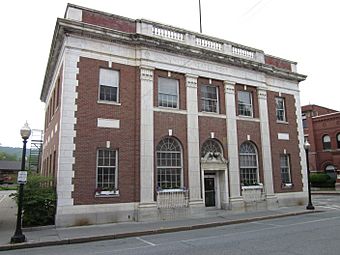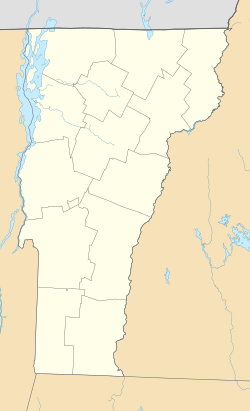White River Junction Historic District facts for kids
|
White River Junction Historic District
|
|

The former post office building
|
|
| Location | Railroad Row, Main, Currier, Bridge, and Gates Sts. (original); N. Main St., S. Main St. Bridge St., Gates St. and Church St. (2002 increase), Hartford, Vermont |
|---|---|
| Area | 12 acres (4.9 ha) (original) 30 acres (12 ha) (after 2002 increase) |
| Architectural style | Greek Revival, Colonial Revival, Richardsonian Romanesque (original); Italianate, Romanesque (increase) |
| NRHP reference No. | 80000390 (original) 02001553 (increase 1) 100004755 (increase 2) |
Quick facts for kids Significant dates |
|
| Added to NRHP | August 22, 1980 |
| Boundary increases | December 20, 2002 December 10, 2019 |
The White River Junction Historic District is a special area in the village of White River Junction, located in the town of Hartford, Vermont. A historic district is a part of a town or city that has important old buildings or sites. These places are kept safe and special because they show how the area used to look and feel.
This district was first added to the National Register of Historic Places in 1980. This is a list of places in the United States that are important to history. The district's size was made bigger in 2002 and again in 2019. It started by covering the main business area of the village. Later, it grew to include more interesting buildings and places.
Contents
About White River Junction
The village of White River Junction is in the eastern part of Vermont. It sits right where the White River flows into the larger Connecticut River. People first settled here in the 1760s.
A Hub for Trains
From the 1840s to the 1960s, White River Junction was super important for trains in northern New England. It was like a giant meeting point where different train lines connected. Trains from places like Boston, Burlington, and Concord, New Hampshire all met here.
Some of the big train companies that used this junction included:
- The Boston and Maine Railroad
- The Central Vermont Railway
- The Passumpsic Rivers Railroad
- The Northern New Hampshire Railroad
- The Woodstock Railway
This made the village a busy place for trade and travel.
Village Growth and Change
The main business area of White River Junction grew a lot during its busiest train years. Most of this growth happened to the west and south of the train tracks. Homes were built on the hills around the village and across the White River.
However, after the mid-1900s, fewer trains used the junction. This caused the village's economy to slow down.
What You Can See in the District
When the historic district was first created in 1980, it included the main business area. This part was around Main and Gates Streets. It also included the old train station, which is still used today by Amtrak's Vermonter service.
Expanding the Historic Area
In 2002, the district was made larger. It now includes most of the business area and some nearby neighborhoods where people live.
- The central part of the business district has many brick buildings. These buildings are usually two or three stories tall.
- Further out on streets like South and North Main Street, the buildings are not as close together. You can find some commercial buildings made of wood there.
The expanded historic district also includes:
- The old railroad bridge that crosses the White River.
- The high school building, built in 1884 and 1895, located on the north side of the White River.
- The Progressive Market, which is an important example of an old local market building.



